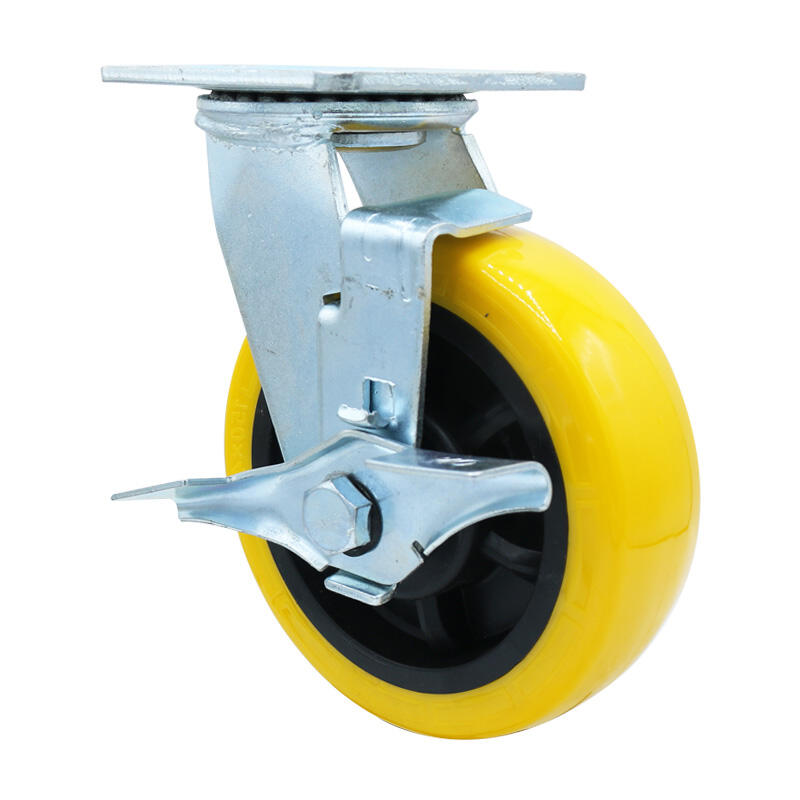先進的な移動ソリューションによる工業効率の最大化
現代の急速な産業環境において、信頼性の高い物料搬送設備の重要性は強調してもしすぎることはありません。 重荷重用キャスターホイール 世界中の製造施設、倉庫、生産工場において重要な構成要素となっています。これらの堅牢な移動ソリューションは、重い荷物をスムーズに動かすことを可能にすると同時に、職場の安全性と運用効率を確保します。その重要性を理解し、効果的に導入することで、工場の生産性と利益を飛躍的に向上させることが可能です。
産業用グレードのキャスターシステムの必須機能
優れた耐荷重性能
現代の高耐荷重キャスターホイールは、非常に重い重量を支えるように設計されており、多くの場合、ホイール1つあたり数千ポンドを超える負荷に耐えられます。これらの頑丈な部品は、高品質な材料と精密な製造工程を用いて、極端な条件下でも一貫した性能を保証しています。特殊なホイールコア、補強されたハウジング、および最適化された重量分散機構により、早期摩耗や構造的疲労を防ぎ、耐荷重能力が向上しています。
先進的な材料技術
材料科学の進化により、キャスターホイールの構造が革新されました。今日の高耐荷重キャスターホイールには、耐久性と衝撃吸収性を兼ね備えた革新的な複合素材が使用されています。ポリウレタン混合物、高品位鋼合金、特殊ゴム素材が協働して、摩耗、化学薬品、環境要因に抵抗し、かつ最適な転がり性能を維持するホイールを実現しています。
エルゴノミクスデザイン要素
現代のキャスターシステムには、作業者の負担を大幅に軽減する人間工学に基づいた機能が取り入れられています。高精度ボールベアリング、旋回機構、および慎重に計算された車輪の直径が、よりスムーズな移動と押引き力の低減に寄与しています。これらの設計要素により、重い荷物を効率的に移動でき、職場での怪我や作業者の疲労のリスクを最小限に抑えることが可能になります。
製造環境における運用上の利点
生産ワークフローの向上
製造工程に頑丈なキャスターホイールを導入することで、施設全体にわたる円滑な材料の流れが実現します。こうした堅牢な移動ソリューションにより、機器の迅速な再配置、効率的なライン変更、柔軟な生産レイアウトが可能になります。重機や資材を簡単に移動できることで、工程間の停止時間が短縮され、生産全体の効率が向上します。
メンテナンスコストの削減
高品質な頑丈なキャスターホイールは、施設インフラへの重要な長期的投資です。その耐久性と摩耗に対する強さにより、交換頻度が減り、メンテナンスの必要も少なくなります。これにより、運用コストが低下し、ホイールのメンテナンスや交換による生産の中断を最小限に抑えることができます。
職場 の 安全 改善
工業環境では安全性が最も重要であり、現代のキャスターシステムはより安全な作業環境の実現に直接貢献しています。つま先保護ガード、制動装置、安定したスウィベル設計などの機能により、事故やけがを防ぎます。頑丈なキャスターホイールの信頼性の高い性能は、重い荷物の制御された移動を保証し、機器の転倒や予期しない動きのリスクを低減します。
経済的インパクトと投資収益
長期コスト分析
高品質の頑丈なキャスターホイールへの初期投資は、基本的な代替品よりも高くなる場合がありますが、長期的な経済的メリットは非常に大きいです。長寿命化、メンテナンス頻度の低減、運用効率の向上により、時間の経過とともに大幅なコスト削減が実現します。高品質なキャスターシステムに投資した施設では、機器の損傷減少、交換頻度の低下、生産性の向上を通じてリターンを得ているケースが多く見られます。
生産性の向上
適切な頑丈なキャスターホイールを導入することで、職場の生産性を実際に測定可能なレベルで向上させることができます。材料の移動速度の向上、作業者の疲労軽減、設備のダウンタイム短縮がすべて寄与して、運用生産量が高まります。こうした効率の改善は、生産能力の増加と資源活用の最適化を通じて、直接的に利益に影響を与えます。
環境と持続可能性の考慮
環境にやさしい材料と生産
現代の高耐荷重キャスターホイールは、環境に配慮した設計要素や製造プロセスを取り入れていることが一般的です。持続可能な材料、省エネルギー型の生産方法、リサイクル可能な部品により、環境への影響が低減されています。メーカー各社は、性能を維持しつつ企業の持続可能性目標を支援する、環境に優しいソリューションの開発にますます注力しています。
運用におけるエネルギー効率
高品質なキャスターホイールの転がり効率は、物流作業におけるエネルギー消費に直接影響します。優れた設計の高耐荷重キャスターホイールは、荷物を動かすために必要な力が少なくなるため、動力機器の電力消費が削減され、手動操作時の身体的負担も軽減されます。このエネルギー効率性は、環境保護と運用コストの削減の両方に貢献します。
導入および統合戦略
評価および選定プロセス
高耐荷重キャスターホイールの成功した導入には、施設の要件を徹底的に分析することが不可欠です。荷重の大きさ、環境条件、床面の種類、使用頻度などの要素を慎重に評価する必要があります。専門的な評価を行うことで、運用上の利益を最大限に引き出すための最適なホイールの選定と配置が可能になります。
設置およびトレーニング手順
高耐荷重キャスターホイールのメリットを最大限に活用するためには、適切な設置とオペレーターへのトレーニングが極めて重要です。これには正しい取り付け手順、定期点検の手順、およびメンテナンススケジュールが含まれます。包括的なトレーニングにより、安全な操作が保証され、キャスターシステムの耐用年数が延びます。
よく 聞かれる 質問
頑丈なキャスターホイールはどのくらいの頻度で点検すべきですか?
定期的な点検は少なくとも月に1回実施するべきであり、使用頻度の高い環境ではより頻繁なチェックが必要です。主な点検項目には、ベアリングの状態、車輪の摩耗、旋回機構の作動状況、取り付け部の確実性が含まれます。日常的なメンテナンス計画を確立することで、予期せぬ故障を防ぎ、最適な性能を維持できます。
キャスターホイールを選定する際に、どの程度の耐荷重を考慮すべきですか?
頑丈なキャスターホイールを選定する際には、全負荷重量を計算し、それをホイールの数で割った後、少なくとも25%の安全係数を加えてください。動的負荷、衝撃荷重、性能に影響を与える可能性のある環境要因も考慮してください。常に最低要件よりも高い耐荷重能力を持つ製品を選ぶことが望ましいです。
環境条件はキャスターホイールの選定にどのように影響しますか?
温度、湿度、化学物質、床面の状態などの環境要因は、キャスターホイールの性能に大きく影響します。使用する作業環境に特化して規定された素材や設計を選定してください。頑丈なキャスターホイールを選ぶ際には、耐化学性、使用温度範囲、床面との適合性などの要因を検討する必要があります。

